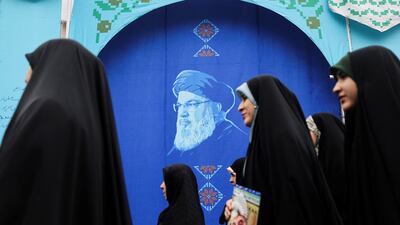If you hear of Iranian police forcibly bringing an end to a hijab-related rally in front of the parliament, you might imagine this was a classic case of the Islamic Republic suppressing its pro-democracy civil society.
But on March 29, the Iranian police forces did this to an entirely different crowd: hardcore supporters of the government who had been calling for stronger enforcement of the mandatory hijab rule, complaining that too many women were openly disregarding the law by not covering their hair.
The demonstrators had organised a sit-in that had gone on for almost two months before it was shut down by the police, based on a decision by Iran’s national security council. Unlike anti-government demonstrators, dozens of whom have been killed in the past few years, the pro-hijab rallies were largely tolerated until this dramatic measure put an end to them. Even then, they were treated with respect, and many were driven to central locations in Tehran from which they could reach home easier.
Still, according to the authorities, at least 30 of the demonstrators resisted being moved while insulting the police and showing aggressive behaviour. Some female demonstrators who were coming from outside Tehran were left at the shrine of Ayatollah Ruhollah Khomeini, founder of the Islamic Republic, in Qom, where they could stay overnight.
Videos of some of these demonstrators complaining to cameras in front of the shrine have gone viral. According to the police, video of a woman who shows her bloodied face is misleading since she spread the blood on her own face, giving the impression that she was beaten up.
The protesters have a simple demand. They want the government to implement the hijab and chastity bill that was ratified by the Iranian parliament last year. The new law would maintain a massive crackdown on millions of Iranian women, who continue to engage in civil disobedience by not covering their hair. Even now many are arrested or fined but if the bill was to be implemented, the government forces would have to arrest tens of thousands of people.
Iran’s new status quo on hijab is a major achievement of the 2022-23 protests that were organised around the slogan “Women, Life, Freedom.” Although the movement wasn’t able to abolish Iran’s mandatory hijab rule, it encouraged mass disobedience of it so that hijab-less women are now the norm across many Iranian streets. The ultraconservative backlash wants to push Iran back to the pre-2022 days. This is why the hardliner parliament passed the hijab bill.
But, last year, Iran's reformist President, Masoud Pezeshkian, said the law was impossible to implement given the country’s conditions. The national security council agrees and has stopped the bill from being turned into law despite it having passed all the necessary steps. Mr Pezeshkian’s legal team is now preparing suggested amendments and wants the bill to go back to the Majlis. Bagher Qalibaf, the conservative Speaker of the parliament, has also conceded that the law has “some problems,” although he was instrumental in its passing in his role as speaker.
Some hardline MPs, such as Hamid Rasaei and Amir-hossein Sabeti, have decried the crackdown. Whoever ordered it was “either stupid or an infiltrator,” Mr Rasaei said while Mr Sabeti said the authorities had no right to clear off the encampment. This despite the fact that the pro-hijab rallies did not have the necessary permission from the interior ministry to organise a rally.
On the other side, some of Mr Pezeshkian’s supporters are heartened. Mohammad Ali Ahangaran, an activist and son of a major military singer, compared the crackdown to “what Khomeini did to the super-revolutionaries in the 1980s.” He was likely pointing out to Mr Khomeini’s well-known decree in late 1982, in which he tried to push back the unruly authorities of the newly established Islamic Republic and barred them from illicit searching people’s homes and cars. That was Mr Khomeini’s attempt to inject some stability into Iran’s turbulent post-revolutionary society. The decision to not implement the hijab bill also aims at bringing stability, just when Iran faces grave threats from outside its borders.
Even some hardliner MPs acknowledge that any attempt to enforce a harsher hijab rule on Iranian women could backfire. Mahmoud Nabavian, the top Tehran MP in the 2024 elections and a member of the hardliner Paydari Front, claimed that some “extremists” had instigated the pro-hijab rallies.
Remarkably, Mr Nabavian said that regional events such as the fall of the Assad rule in Syria and the killing of Hezbollah leader Hassan Nasrallah had changed the conditions. “We passed the hijab bill before these events but now we must do all we can to stop polarisation,” he said.
In other words, Mr Nabavian claimed that Iran’s defeats regionally meant that it did not have the privilege of pushing a strict domestic policy that could further destabilise the country. The same “extremists” who helped organise the pro-hijab rallies had previously pushed Iran to attack Israel, he added, making his point clearer.
But the pro-hijab demonstrators are not cowed. On their messages in the Iranian messaging and social media app, Eitaa, they’ve attacked the Iranian authorities as “coup plotters” and continue to call on people to join a new protest in front of the Majlis.
That the Iranian authorities would decide to crack down on pro-hijab rallies shows how careful they are not to further inflame society. Although Mr Pezeshkian has not yet delivered on some of his signature electoral promises, such as a significant liberalisation of the internet, he knows that any attempt at violent enforcement of mandatory hijab could break the camel’s back and disrupt the social equilibrium. The Iranian authorities would do all they can to avoid this.


